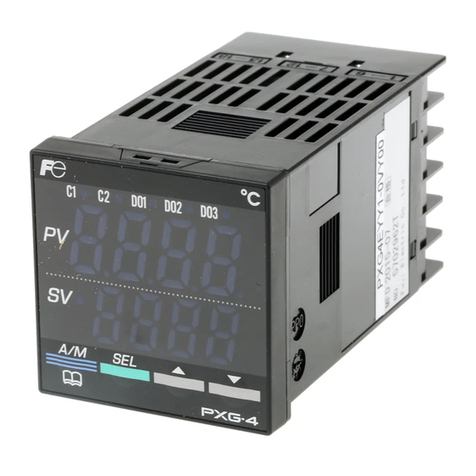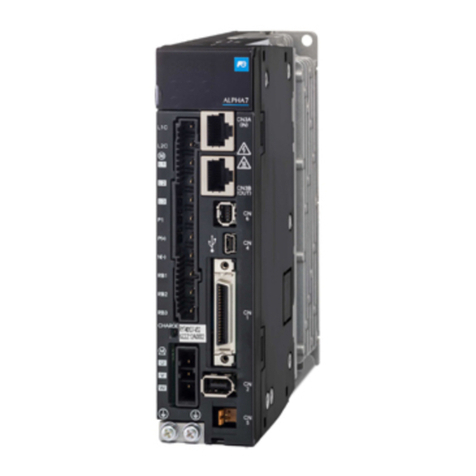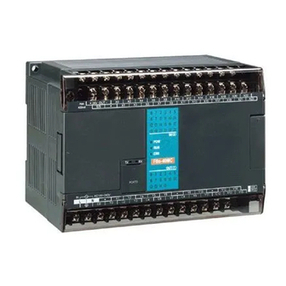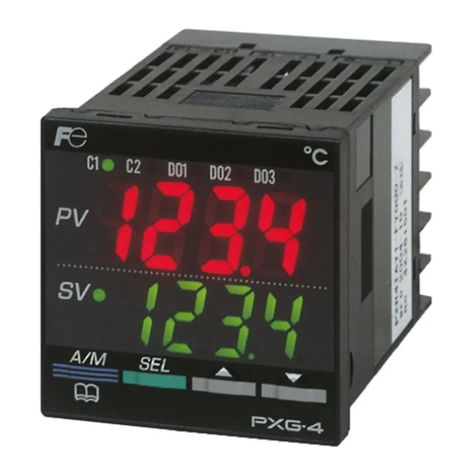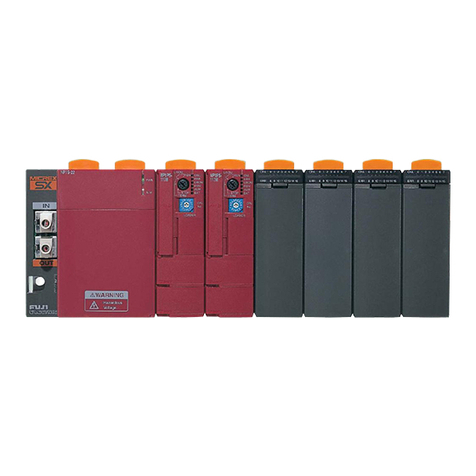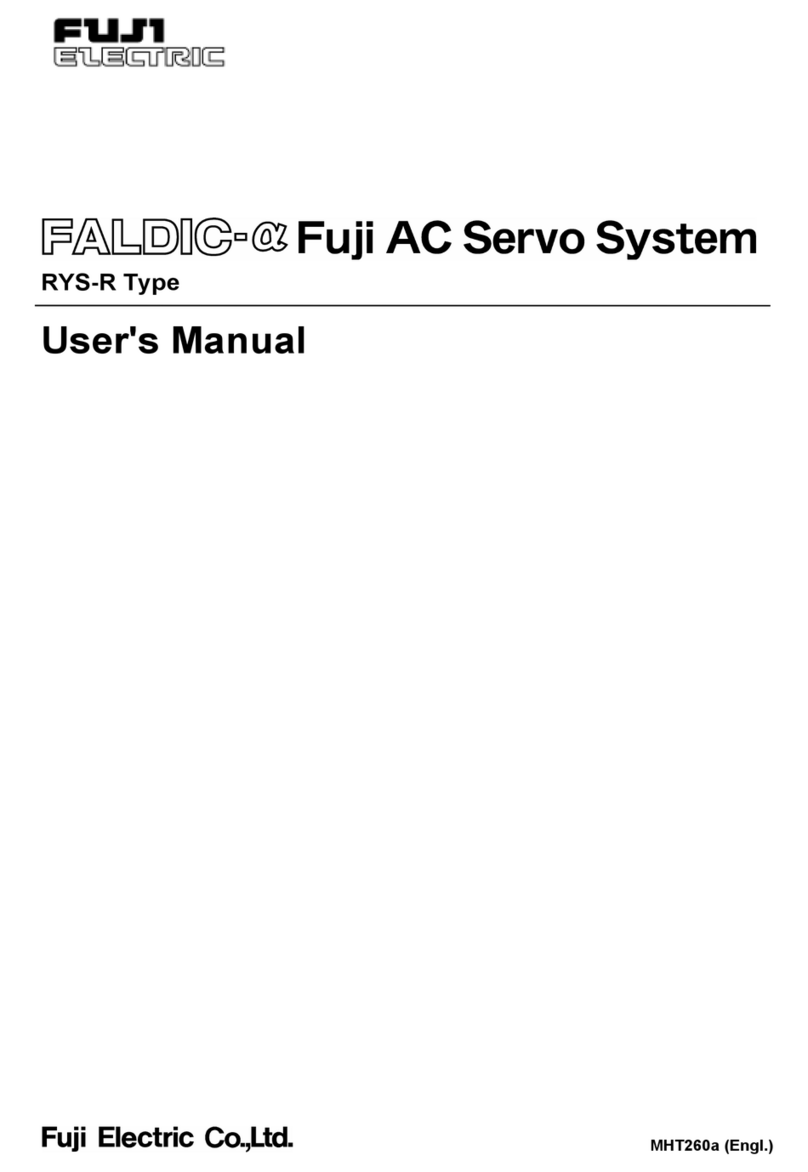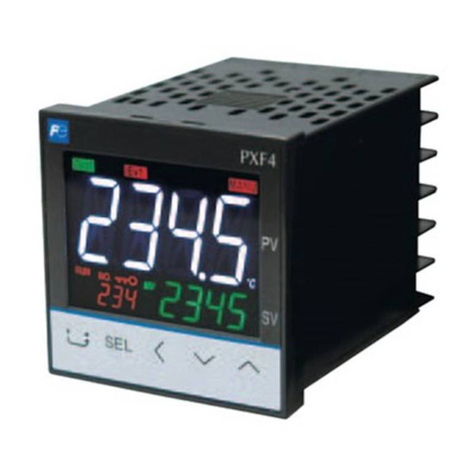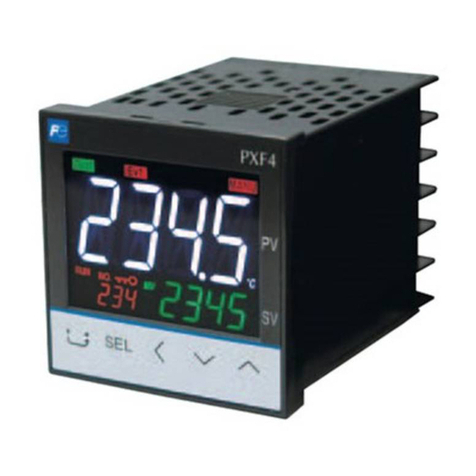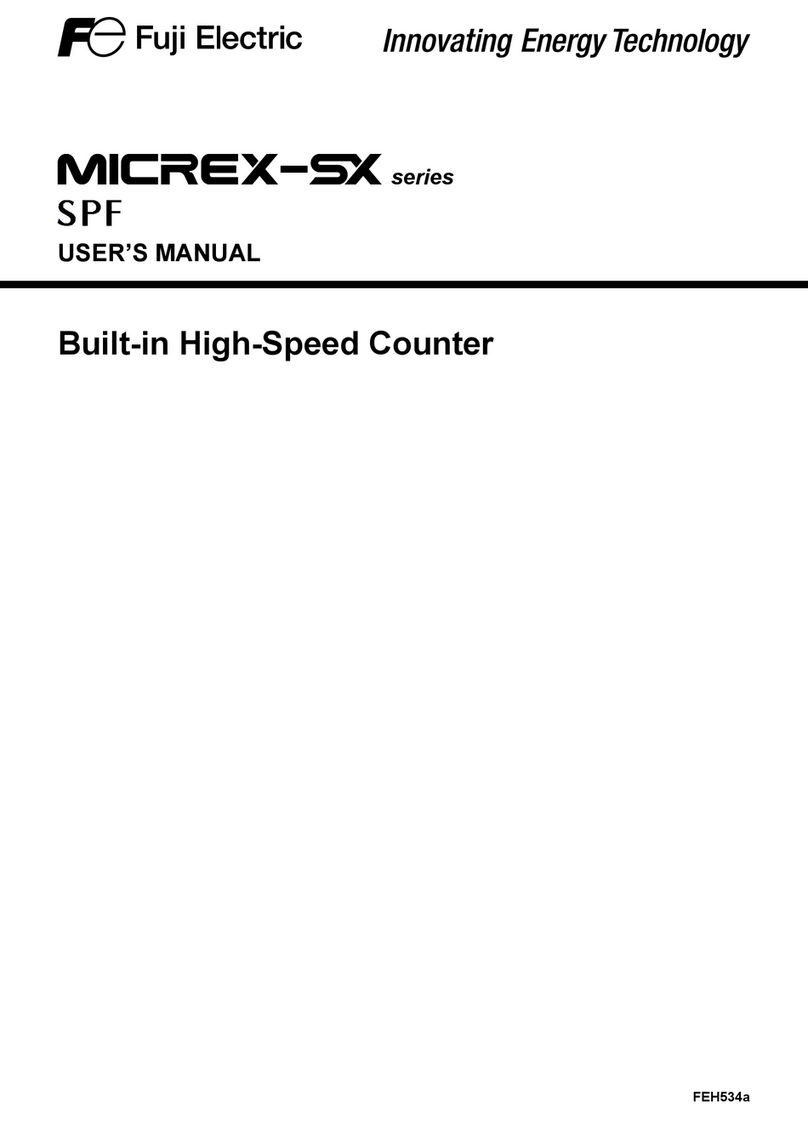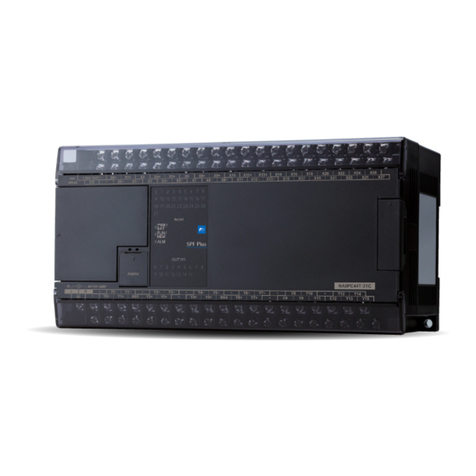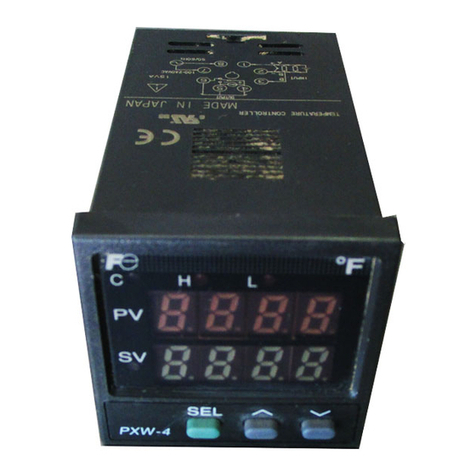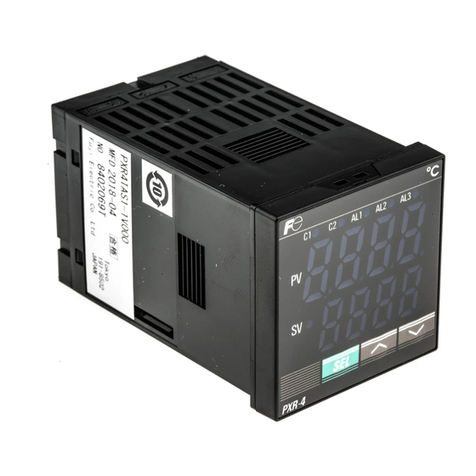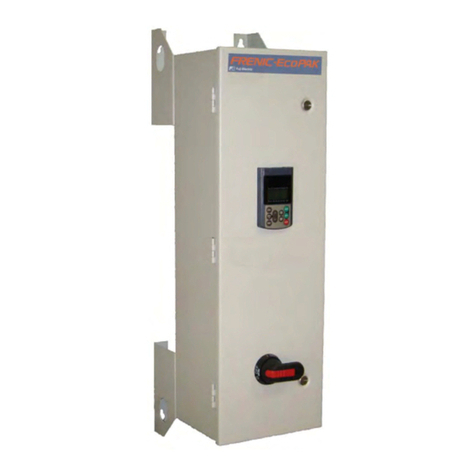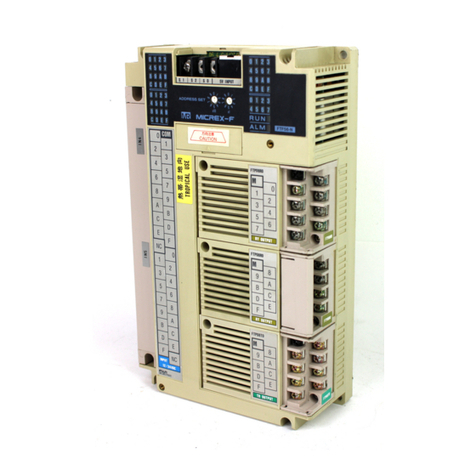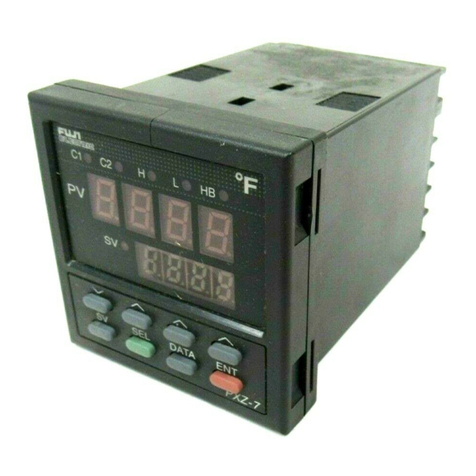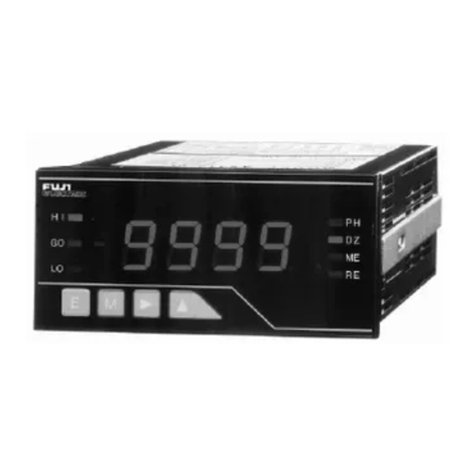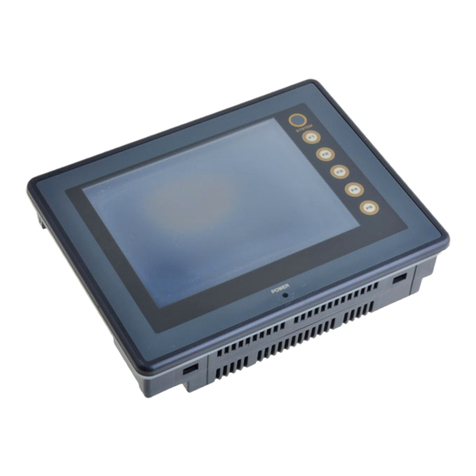INP-TN2PXF4UF-E
Model : PXF4
Micro Control X
(Socket terminal type)
Thank you for purchasing the Fuji digital temperature controller.
Once you have confirmed that this is the product you ordered, please use
it in accordance with the following instructions.
For detailed information on operating this equipment, please refer to the
separate user’s manual.
In addition, please keep this instruction manual within easy reach of the
actual person using this equipment.
Gate City Ohsaki, East Tower, 11-2, Osaki 1-chome, Shinagawa-ku,
Tokyo 141-0032, Japan
Phone: +81-3-5435-7111
www.fujielectric.com
www.fujielectric.com/products/instruments/
Confirming Specifications and Accessories
●Before using the product, confirm that it matches the type
ordered.
(For model code, please refer to “12. Model Specifications”.)
●Confirm that all of the following accessories are included.
Temperature Controller1 unit
Mounting bracket 1 pc
Instruction Manual 1 copy Waterproof packing 1 pc
Option
Name
Quantity
Order No.
PC loader communication cable 1 cable ZZP*TQ501923C3
Without alarm functions 8-pin socket
TP48X type (for rail mounting)
1 pc *ZZPPXF2-C100
Without alarm functions 8-pin socket
TP48SB type (for panel mounting)
1 pc *ZZPPXF2-C101
With alarm functions 11-pin socket
TP411X type (for rail mounting)
1 pc *ZZPPXF2-C102
With alarm functions 11-pin socket
TP411SBA type (for panel mounting)
1 pc *ZZPPXF2-C103
Related Information
Refer to the following reference materials for details about the
items described in this manual.
Document Reference No.
Micro Controller (Model: PXF) Operation
Manual INP-TN5A2400-E
The latest manuals can also be downloaded at the following
URL:
www.fujielectric.com/products/instruments/
Safety Information (Please Read First)
Please read this section thoroughly before using and observe
the mentioned safety warnings fully.
Safety warnings are categorized as “Warning” or “Caution”.
Failure to follow the instructions may result in a safety hazard.
Warning Mishandling may lead to minor or serious
personal injury, fire, and/or property damage.
Caution Mishandling may cause injury to the user or
property damage.
If the equipment is used in a manner not specified by the
manufacturer, the protection provided by the equipment may be
impaired.
1. Warning
1-1. Limitations in Use
This product is a temperature controller which was developed, designed and manufactured on the premise that it would be used for
general machinery. In particular, if this product is to be used for applications that require the utmost safety as described below, please
take into consideration of the safety of the entire system and the machine by adopting such means as a fail-safe design, a redundancy
design as well as he conducting of periodical inspections.
●Safety devices for the purpose of protecting the human body
●Direct control of transportation equipment
●Airplanes
●Space equipment
●Atomic equipment, etc.
Please do not use this product for applications which directly involve human lives.
1-2. Installation and Wiring
●This equipment is intended to be used under the following conditions.
Ambient temperature -10 °C to 50 °C
Ambient humidity 90% RH or below (with no condensation)
Overvoltage category II by IEC 61010-1
Pollution degree 2
Recommended fuse 250 V AC, 0.1 A, T(Time-Lag) (100 to 240 V AC),
400 V DC/AC, 1 A, T(Time-Lag) (24 V DC/AC)
Usage environment Indoor use
●For 24 V DC/AC power supply model, if the equipment is connected to the Safety Extra Low Voltage (SELV) circuit, a basic
insulation* must be provided between the SELV circuit and the power input terminals. Otherwise, the power input terminals must
be connect to Extra Low Voltage (ELV) circuit so as to prevent the electric shock.
About safety standard
Please observe the following instructions to meet the requirements of safety standard. Failure to observe these instructions
violates safety standards. (This product is not a safety equipment.)
………………………………………………………………………………………………………………………………………………………………………………………………………
●Install a recommended fuse, which is specified in the instruction manual, between the external main power (mains circuit)
and this equipment.
●
If accessible Safety Extra Low Voltage (SELV) circuits are to be connected to Signal input terminal, SSR Drive output terminal
or Current output terminal, ensure to provide a basic insulation* between the SELV circuits and these terminals (For example,
use transformer which has a basic insulation* or higher degree of insulation).
●
Whole this equipment must be mounted in an enclosure in order to prevent the electric shock and spread of fire.
●Be sure to install an appropriate external protective circuit to prevent excessive temperature rise etc.
●When performing wiring work, be sure to turn the power off and to wear protection gloves or safety glasses, to prevent an
electric shock.
●Set proper parameter input signals which correspond to each input to be connected. Be careful not to confuse voltage input
with current input, or vice versa.
●
Do not use this equipment for the measurement of circuits which falls under measurement categories II, III, or IV.
●Do not use this equipment for measurement of signals to which a voltage over
30 VRMS or over 60 V DC is applied.
………………………………………………………………………………………………………………………………………………………………………………………………………
* The basic insulation requires a clearance at least 1.5 mm and a creepage of at least 3.0 mm. If such insulation is not provided,
the UL61010 and EN61010 safety compliance may become invalid.
●If the voltage exceeds 50 V DC (which is called as hazardous voltage), install a basic insulation between all terminals and the
ground, and supplementary insulation on the digital outputs.
Note that the insulation class for this equipment is as follows. Before installing, please confirm that the insulation class for
equipment meets usage requirements.
Basic insulation (1500 V AC) Functional insulation (500 V AC) No insulation
Power supply (100 to 240 V AC) Internal circuit
Power supply (24 V DC/AC)
Control output 1 (relay contact) Process value input
Alarm output 1 to 2 (relay contact) Control output 1 (SSR drive, current)
●In case where damage or problems with this equipment may lead to serious accidents, install appropriate external protective
circuits.
●As this equipment has no power switch or fuse, install them separately as needed.
If you install a fuse, be sure to place it between the main power switch and this equipment. (Main power switch: double-pole
breaker, fuse rating: 250V, 1A)
●A power switch or a circuit breaker should be installed within the power supply facility.
●A power switch or a circuit breaker should be properly installed within easy reach of an operator.
●A power switch or a circuit breaker should be identified as the one for this product.
●Electrical wiring must be made by the qualified personnel only and in accordance with your local and national standards.
●For power supply wiring, use wire equal to 600 V vinyl insulated wire or above.
●To prevent damage and failure of the equipment, provide the rated power voltage.
●To prevent shock and equipment failure, do not turn the power ON until all wiring is complete.
●Before turning on power, confirm that clearance space has been secured to prevent shock or fire.
●Do not touch the terminal while the machine is on. Doing so risks shock or equipment errors.
●Never disassemble, convert, modify or repair this equipment. Doing so risks abnormal operation, shock or fire.
●If any failure occurs, please contact the manufacturer and return the product.
●Output relay is the part has a limited life. When output relay contact comes to the end of its life, it might remain on-state, or off-
state. For safety, use a protective circuit outside.
●The factory default setting of this equipment is as follows. Change the setting as necessary so as the equipment to meet your
application. Please note that the improper settings may result in overheat or unexpected damage. For the details of operation,
refer to the separate volume, “Operation Manual (INP-TN5A2400-E)”.
Control output 1: heating control Alarm output 1 to 2 (optional): No function
●Symbols on the instrument
: Read this instruction manual thoroughly before using the product, and usethe product safely.
1-3. Maintenance
●When installing or removing the equipment, turn the power OFF. Otherwise, shock, operational errors or failures may be caused.
●Periodic maintenance is recommended for continuous and safe use of this equipment.
●Some parts installed on this equipment have a limited life and/or may deteriorate with age.
●
The warranty period for this unit (including accessories) is three years after the date of manufacture, if the product is used properly.
2. Caution
2-1. Cautions when Installing
●Please avoid installing in the following locations.
Locations in which the ambient temperature falls outside the range of –10 to 50 °C when equipment is in use.
Locations with rapid temperature changes, leading to dew condensation
Locations with corrosive gases (especially sulfide gas, ammonia, etc.) or flammable gases.
Locations with vibration or shock directly. (Vibration and shock may cause output relay malfunction.)
Locations in contact with water, oil, chemicals, steam or hot water. (If the equipment gets wet, there is a risk of electric shock
or fire, so have it inspected by Fuji distributor.)
Locations with high concentrations of atmospheric dust, salt or iron particles.
Locations with large inductive interference, resulting in static electricity, magnetic fields or noise
Locations in direct sunlight.
Locations that build up heat from radiant heat sources, etc.
●Recommended site conditions
A place where the ambient humidity during operaion is between 45 to 85% RH.
About EMC standard
●This equipment is a class A , for industrial locations, equipment. Do not use this equipment in domestic establishment, such
as residential areas, or it may cause radio interference. If you use this equipment in domestic locations, take adequate
measures on the outside of the equipment to reduce radio interference.
●Under the requirement of EMC standard, the maximum length of external cable including a sensor to be connected to this
equipment is 30 m. Do not connect the sensor longer than 30 m.
2-2. Cautions when Attaching to the Panels
●Insert the controller unit into the panel cutout from the front, and then put the mounting bracket from the rear. The mounting
bracket should be pushed in until the controller is securely fixed to the panel. If there is a slight gap remaining, gently tighten the
two screws until the gap disappears. (Make sure not to over tighten the screws, as doing so may result in the mounting bracket
separating from the stopper.)
●The front of this equipment is waterproof in compliance with NEMA-4X standards (IP66- equivalent). To effect waterproof, the
included packing is shall be attached between the controller and the panel according to the guidelines below. (Incorrect
attachment may cause the equipment to lose its waterproof capabilities.)
(1) As shown in Fig. 1, insert to the panel after attaching the packing to the equipment case.
(2) As shown in Fig. 2, tighten the screws of the mouthing bracket so that no gaps can remain between the equipment face, the
packing and the panels. Once finished, confirm that there are no changes in shape such as displaced or improperly-fitted
packing, etc. as shown in Fig. 3
< Attachment on vertical surface (Horizontal attachment) >
Mounting
bracket Packing
Case
(Good)
Case
Fig. 3
Case
(Bad)
Fig. 2Fig. 1
PanelPanel Screw
UnitUnit
Front
Packing
●Note that NEMA-4X and IP66 are not subject to UL/cUL certificate.
●
If the panel does not have enough strength, gaps may develop between the packing and the panel to lose waterproofing capabilities.
●In order to aid heat dissipation, do not block the sides of the equipment.
●Do not block the air vents on the top and bottom of the case.
2-3. Cautions for Wiring
●For thermocouple input, use the designated compensation lead; for resistance bulb input, use wires with small lead wire
resistance and without any resistance difference among the three wires.
●To avoid noise conductor effects, input signal wires should be separated from electric power lines or load lines.
●Input signal wire and output signal wire should be separated each other. And both should be shield wire.
●If there is a lot of noise from the power source, adding an insulation transducer and using a noise filter is recommended. Always
attach a noise filter to a panel that is grounded securely, and keep the wiring between the noise filter output side and the
measuring equipment power terminal wiring to a minimum length. Please do not attach fuses and switches, etc. to the noise filter
output wiring; otherwise the filter’s effectiveness will be decreased.
●Twisting the power wires is effective when connecting the wires. (The shorter the pitch of the twist, the more effective the
connection is against noise.)
●Operation preparation time is required for the contact output when power is turned on. If using it as a signal to an external
interlock circuit, please couple it with a delayed relay.
Concerning the output relay, connecting the maximum rated load will shorten the product’s life; so please attach an auxiliary
relay. If the output operation frequency is high, selecting a SSR drive output type is recommended.
[Proportionate cycles] Relay output: 30 seconds or more, SSR drive output: 1 second or more
●When inductive loads such as magnetic opening/closing equipment, etc. as relay output equipment are
connected, use of a surge absorber is recommended in order to protect the contacts against opening/closing
surges and to ensure long-term use. Recommended specification for the surge absorber
Voltage Nominal varistor voltage
100 V 240 V
200 V 470 V
Attachment position: between the relay control output contacts.
2-4. Key Operation Cautions/Error Operations
●The alarm function does not work properly when an error takes place unless the settings are made correctly. Always verify its
setting before operation.
●If the input wiring breaks, the display will read “UUUU” or “LLLL”. When replacing the sensor, always turn the power OFF.
2-5. Others
●Please do not wipe the equipment with organic solvents such as alcohol or benzene, etc. If wiping is necessary, use a neutral
cleaning agent.
●Do not use mobile phones near this equipment (within 50 cm). Otherwise a malfunction may result.
●Trouble may occur if the equipment is used near a radio, TV, or wireless device.
●This equipment should be treated as an industrial waste when it is disposed of.
CAUTION
The contents of this manual are subject to change without notice.
This manual is complied with possible care for the purpose of
accuracy, however, Fuji Electric shall not be held liable for any
damages, including indirect damage, caused by typographical
errors, absence of information or use of information in this manual.
3-1. Scope of warranty
If malfunction occurs in the period of warranty due to Fuji Electric, the malfunctioning parts are exchanged or repaired for free. However,
in the case where an engineer needs to visit your place for replacement or repair, you will be charged our call out fee. Please note that
we cannot provide commissioning and/or readjustment for whole system including our product at repair or replacement of failed parts.
The warranty does not apply to the following cases.
(1) The malfunction occurs due to inappropriate conditions, environment, handling or usage that is not instructed in a catalog,
instruction book or user’s manual.
(2) The malfunction is caused by the factors that do not originate in the purchased or delivered product.
(3) The malfunction is caused by other devices or software design that does not originate in Fuji Electric products.
(4) The malfunction occurs due to an alteration or repair that is not performed by Fuji Electric.
(5) The malfunction occurs because the expendable parts listed in an instruction book or connectable were not maintained nor
exchanged in an appropriate manner.
(6) The malfunction occurs due to factors that were not foreseeable by the practical application of science and technology at the
time of purchase or delivery.
(7) The malfunction occurs because the product is used for an unintended purpose.
(8) The malfunction occurs due to a disaster or natural disaster that Fuji Electric is not responsible for.
3-2. Exclusion of liability for loss of opportunity
Regardless of the time period of the occurrence, the amount of compensation assumed by Fuji Electric for damage, excluding
which is caused by intentional acts or acts of gross negligence or illegal act by Fuji Electric, shall not exceed the amount stipulated
in the contract with the customer.
Fuji Electric is not liable for the damage to products that were not manufactured by Fuji Electric, incidental damages or
consequential damages, or damage caused due to special situations regardless of whether it was foreseeable or not, or passive
damages such as opportunity loss or lost profits of the purchaser.
3-3. Scope of application
●This equipment must be used under the following conditions:
The use of the equipment incurs no risk of a serious accident even if a failure or malfunction occurs on the equipment, and in
case of product failure or malfunction, safety measures such as redundant design, prevention of malfunction, fail safe setting,
foolproof mechanism are provided outside of the equipment by the user.
●
The product described in this document is designed and manufactured as a general-purpose products for general industrial applications.
●The warranty does not apply to the following cases:
For the use not described in or beyond the conditions or environment specified in the instruction manual or the user manual,
For the use which has large influence on publicity including nuclear power and other power generation, gas, and/or water,
For the use in which safety is especially required, because it may seriously affect railroads, vehicles, combustion equipment,
medical equipment, entertainment devices, safety equipment, defense equipment, and/or human lives and property.
However, we will study the possibility of application of the equipment for the above use, if the user limits the usage of it and agrees
to require no special quality. Please consult us.
3. Limited warranty
Example
